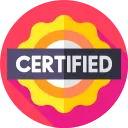FREE
daily Instructor: Dr. Kaitlin SchultzCourse Overview
Hydraulic System Inspection and Diagnostics
Hydraulic Fluid Analysis and Interpretation
- Understanding the properties of hydraulic fluids, including viscosity, viscosity index, pour point, flash point, and fire point, and how these properties affect system performance.
- Performing fluid sampling techniques to ensure representative samples are obtained for accurate analysis.
- Interpreting fluid analysis reports to identify contamination levels (e.g., particle count, water content, metallic debris), fluid degradation, and potential component wear.
- Identifying the sources of contamination and implementing preventative measures to minimize future contamination, such as installing filtration systems and improving sealing techniques.
- Understanding different types of hydraulic fluids (e.g., mineral oil-based, synthetic, water-glycol) and their compatibility with system components.
Hydraulic Component Inspection and Testing
- Inspecting hydraulic pumps for cavitation, aeration, and mechanical wear by analyzing noise, vibration, and temperature.
- Testing hydraulic cylinders for leaks, rod damage, and seal failures using pressure testing and visual inspection techniques.
- Evaluating hydraulic valves (e.g., directional control valves, pressure relief valves) for proper function, spool wear, and internal leakage using flow meters and pressure gauges.
- Examining hydraulic hoses and fittings for cracks, abrasions, and leaks, and verifying proper hose routing and support to prevent premature failure.
- Analyzing hydraulic accumulators for pressure retention, bladder integrity, and gas leakage using pre-charge testing and visual inspection.
Hydraulic System Troubleshooting and Repair
- Diagnosing hydraulic system malfunctions using diagnostic tools such as pressure gauges, flow meters, and thermal imaging cameras.
- Identifying the root causes of hydraulic system failures, such as pump failures, valve malfunctions, and cylinder leaks, using a systematic troubleshooting approach.
- Performing hydraulic system repairs, including replacing damaged components, repairing leaks, and adjusting system pressures.
- Flushing hydraulic systems to remove contaminants and debris after repairs to ensure optimal system performance.
- Rebuilding hydraulic cylinders, pumps, and valves to restore them to their original operating condition.
Electrical System Inspection and Diagnostics
Electrical Component Testing and Troubleshooting
- Using multimeters to measure voltage, current, and resistance in electrical circuits.
- Testing sensors (e.g., pressure sensors, temperature sensors, proximity sensors) for proper function and accuracy using signal generators and oscilloscopes.
- Evaluating switches, relays, and solenoids for continuity, coil resistance, and proper operation using multimeters and circuit testers.
- Inspecting wiring harnesses for damage, corrosion, and loose connections, and repairing or replacing damaged wiring as needed.
- Diagnosing electrical system faults using wiring diagrams, schematics, and diagnostic software.
Electrical System Safety Procedures
- Implementing lockout/tagout procedures to de-energize electrical circuits before performing maintenance or repairs.
- Using personal protective equipment (PPE) such as insulated gloves, safety glasses, and arc flash suits to protect against electrical hazards.
- Understanding electrical safety standards and regulations, such as those outlined by OSHA and NFPA.
- Performing electrical safety inspections to identify potential hazards and ensure compliance with safety regulations.
- Recognizing and responding to electrical emergencies, such as electrical fires and electrocutions.
Control System Diagnostics and Repair
- Understanding Programmable Logic Controllers (PLCs) and their role in controlling heavy machinery functions.
- Using diagnostic software to monitor PLC inputs and outputs, identify fault codes, and troubleshoot control system problems.
- Calibrating and adjusting sensors and actuators to ensure proper system performance.
- Replacing faulty PLCs, input/output modules, and other control system components.
- Troubleshooting communication networks (e.g., CAN bus, Ethernet) used to connect control system components.
Engine Inspection and Maintenance
Engine Diagnostics and Performance Analysis
- Performing engine diagnostic tests using diagnostic tools such as compression testers, cylinder leakage testers, and exhaust gas analyzers.
- Analyzing engine performance data, such as horsepower, torque, and fuel consumption, to identify potential problems.
- Inspecting engine components for wear, damage, and leaks, including cylinders, pistons, valves, and bearings.
- Diagnosing engine problems such as misfires, rough running, and excessive oil consumption.
- Evaluating the condition of turbochargers, superchargers, and other forced induction systems.
Engine Maintenance and Repair Procedures
- Performing routine engine maintenance, such as oil changes, filter replacements, and tune-ups.
- Adjusting valve clearances to ensure proper engine performance and prevent valve damage.
- Replacing worn or damaged engine components, such as pistons, rings, valves, and bearings.
- Rebuilding engines to restore them to their original operating condition.
- Troubleshooting and repairing engine cooling systems, including radiators, thermostats, and water pumps.
Fuel System Inspection and Maintenance
- Inspecting fuel lines, fuel filters, and fuel pumps for leaks, damage, and contamination.
- Testing fuel injectors for proper spray pattern, flow rate, and leakage.
- Adjusting fuel injection timing to optimize engine performance and fuel economy.
- Troubleshooting and repairing fuel system problems, such as fuel starvation, fuel leaks, and fuel contamination.
- Understanding the different types of fuel systems (e.g., diesel, gasoline, natural gas) and their specific maintenance requirements.
Structural Inspection and Welding Safety
Visual Inspection Techniques for Structural Integrity
- Performing visual inspections to identify cracks, corrosion, and other structural defects in heavy machinery components.
- Using measuring tools such as calipers, micrometers, and straightedges to assess the dimensions and alignment of structural components.
- Evaluating welds for defects such as porosity, undercut, and lack of fusion.
- Documenting inspection findings using photographs, sketches, and written reports.
- Applying non-destructive testing (NDT) methods such as dye penetrant testing, magnetic particle testing, and ultrasonic testing to detect hidden defects.
Welding Safety Procedures and Hazard Assessment
- Implementing proper ventilation techniques to minimize exposure to welding fumes and gases.
- Using personal protective equipment (PPE) such as welding helmets, gloves, and aprons to protect against welding hazards.
- Understanding the hazards associated with welding, such as electrical shock, burns, and eye damage.
- Performing hazard assessments to identify potential risks and implement control measures.
- Following safe welding practices, such as proper electrode selection, welding technique, and grounding procedures.
Welding Techniques for Repairing Heavy Machinery
- Using different welding processes, such as shielded metal arc welding (SMAW), gas metal arc welding (GMAW), and gas tungsten arc welding (GTAW), to repair heavy machinery components.
- Selecting the appropriate welding process and filler metal for different materials and applications.
- Preparing welding surfaces by cleaning, grinding, and beveling to ensure proper weld penetration and strength.
- Applying welding techniques to repair cracks, weld gouges, and other structural defects.
- Performing post-weld heat treatment to relieve stress and improve weld strength.
Safety Regulations and Compliance
OSHA and ANSI Standards for Heavy Machinery
- Understanding OSHA regulations pertaining to the safe operation and maintenance of heavy machinery, including 29 CFR 1926 (Construction) and 29 CFR 1910 (General Industry).
- Applying ANSI standards for heavy machinery design, manufacture, and operation, such as ANSI B30 standards for cranes, hoists, and other lifting equipment.
- Complying with OSHA requirements for lockout/tagout, fall protection, and confined space entry.
- Implementing safety programs to prevent accidents and injuries involving heavy machinery.
- Understanding the legal implications of safety violations and the importance of maintaining a safe work environment.
Risk Assessment and Hazard Identification
- Performing risk assessments to identify potential hazards associated with heavy machinery operation and maintenance.
- Evaluating the likelihood and severity of potential hazards to determine the level of risk.
- Implementing control measures to eliminate or mitigate identified risks, such as engineering controls, administrative controls, and personal protective equipment (PPE).
- Developing and implementing emergency response plans to address potential incidents, such as equipment failures, fires, and injuries.
- Regularly reviewing and updating risk assessments to reflect changes in operating conditions and equipment.
Emergency Procedures and First Aid
- Responding to medical emergencies, such as injuries, illnesses, and accidents, by providing first aid and CPR.
- Implementing emergency shutdown procedures to safely stop heavy machinery in the event of a malfunction or accident.
- Evacuating work areas in the event of a fire, explosion, or other hazardous incident.
- Communicating emergency information to relevant personnel, such as supervisors, emergency responders, and medical professionals.
- Maintaining first aid supplies and equipment in readily accessible locations.
FlashCards
External Resources
Add-On Features
Expert Instructor
Get live study sessions from experts
Honorary Certification
Receive a certificate before completing the course.
Currency
Sign in to change your currency
I'm not ready to enroll?
Tell us why, because it matters.
Enroll With a Key
Course Benefits
Get a Job
Use your certificate to stand out and secure new job opportunities.
Earn More
Prove your skills to secure promotions and strengthen your case for higher pay
Learn a Skill
Build knowledge that stays with you and works in real life.
Lead Teams
Use your certificate to earn leadership roles and invitations to industry events.
Visa Support
Use your certificate as proof of skills to support work visa and immigration applications.
Work on Big Projects
Use your certificate to qualify for government projects, enterprise contracts, and tenders requiring formal credentials.
Win Partnerships
Use your certified expertise to attract investors, get grants, and form partnerships.
Join Networks
Use your certificate to qualify for professional associations, advisory boards, and consulting opportunities.
Stand Out Professionally
Share your certificate on LinkedIn, add it to your CV, portfolio, job applications, or professional documents.
Discussion Forum
Join the discussion!
No comments yet. Sign in to share your thoughts and connect with fellow learners.
Frequently Asked Questions
For detailed information about our Heavy Machinery Inspection and Safety Certification course, including what you’ll learn and course objectives, please visit the "About This Course" section on this page.
The course is online, but you can select Networking Events at enrollment to meet people in person. This feature may not always be available.
We don’t have a physical office because the course is fully online. However, we partner with training providers worldwide to offer in-person sessions. You can arrange this by contacting us first and selecting features like Networking Events or Expert Instructors when enrolling.
Contact us to arrange one.
This course is accredited by Govur University, and we also offer accreditation to organizations and businesses through Govur Accreditation. For more information, visit our Accreditation Page.
Dr. Kaitlin Schultz is the official representative for the Heavy Machinery Inspection and Safety Certification course and is responsible for reviewing and scoring exam submissions. If you'd like guidance from a live instructor, you can select that option during enrollment.
The course doesn't have a fixed duration. It has 23 questions, and each question takes about 5 to 30 minutes to answer. You’ll receive your certificate once you’ve successfully answered most of the questions. Learn more here.
The course is always available, so you can start at any time that works for you!
We partner with various organizations to curate and select the best networking events, webinars, and instructor Q&A sessions throughout the year. You’ll receive more information about these opportunities when you enroll. This feature may not always be available.
You will receive a Certificate of Excellence when you score 75% or higher in the course, showing that you have learned about the course.
An Honorary Certificate allows you to receive a Certificate of Commitment right after enrolling, even if you haven’t finished the course. It’s ideal for busy professionals who need certification quickly but plan to complete the course later.
The price is based on your enrollment duration and selected features. Discounts increase with more days and features. You can also choose from plans for bundled options.
Choose a duration that fits your schedule. You can enroll for up to 180 days at a time.
No, you won't. Once you earn your certificate, you retain access to it and the completed exercises for life, even after your subscription expires. However, to take new exercises, you'll need to re-enroll if your subscription has run out.
To verify a certificate, visit the Verify Certificate page on our website and enter the 12-digit certificate ID. You can then confirm the authenticity of the certificate and review details such as the enrollment date, completed exercises, and their corresponding levels and scores.
Can't find answers to your questions?
Certification Guide

Complete the Course
Begin the course by selecting your experience level in the course content section:
Beginner: Master the material with interactive questions and enough time.
Intermediate: Get certified faster with hints and balanced questions.
Advanced: Challenge yourself with more questions and less time

Earn Your Certificate
To download and share your certificate, you must achieve a combined score of at least 75% on all questions answered.





